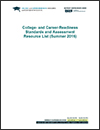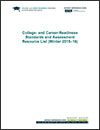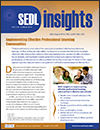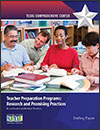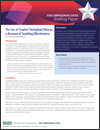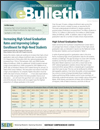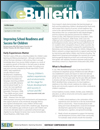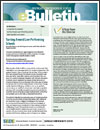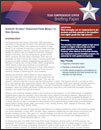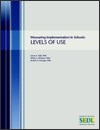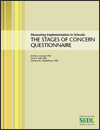SEDL's Free Publications for Improving School Performance
Improving School Performance
Our Most Popular Products in this Subject Area
Use the menu on the left to show additional products in this category.
|
College- and Career-Readiness Standards and Assessment Resource List (Summer 2016) (2016) This biannual update provides a list of resources that focus on college- and career-readiness standards and assessment. |
|
College- and Career-Readiness Standards and Assessment Resource List (Winter 2015–16) (2016) This biannual update provides a list of resources that focus on college- and career-readiness standards and assessment. It includes materials from the federal content centers, comprehensive centers, and regional educational laboratories, as well as other organizations with expertise in education policy, research, and technical assistance. |
|
SEDL Insights, Vol. 2, No. 3: Implementing Effective Professional Learning Communities (2014) “Professional learning communities,” the name given to teachers’ collaborative professional learning—or PLCs, as they are often called—has become so overused that we often don’t think about the term’s meaning. Only when teachers reflect on their instructional practice, consider the impact instruction has on students, and implement insights gained from a meeting to improve their teaching performance, can this process be called a professional learning community. This issue of SEDL Insights explores ways that education leaders can guide their staff in the implementation of effective PLCs. |
|
Identifying Competencies and Actions of Effective Turnaround Principals: Southeast Comprehensive Center Briefing Paper, January 2013 (2013) Research over the past 30 years has found that effective principals can significantly improve various components of student achievement and learning. In addition, there are few examples of improving student achievement that were not led by an effective principal. Research has also identified the need for the change to be systemic or comprehensive in the school turnaround process to ensure sustainability. Along with a systemic improvement process, Duke (2006), identifies 10 “essential” school components for the turnaround principal’s focus and action as keys to sustained success for the benefit of all students. This briefing paper addresses the essential competencies and actions of the turnaround principal. |
|
Rapid Response: Compensation Strategies to Address Teacher Shortages (2012) This resource was produced in response to a request from a state department of education (SDE) served by the Southeast Comprehensive Center (SECC) at SEDL that requested information regarding teacher shortages, specifically merit pay, compensation strategies, and other actions taken or under consideration by SDEs to address this issue. |
|
Teacher Preparation Programs: Research and Promising Practices: Texas Comprehensive Center Briefing Paper, Number 11 (2012) The literature on teacher preparation programs in the United States is extensive. However, there is limited scientifically based research on what kind of program produces effective teachers; rather, the literature consists mostly of calls for change in teacher preparation programs. Almost all experts agree that major changes are needed in these programs, with the emphasis being to produce teachers who are effective in enhancing student learning. This paper reports evidence-based research and offers suggestions based on studies that include theoretical work, qualitative analysis, statistical analysis, and randomized experience that could provide strong causal evidence of the effects of teacher preparation on student learning. |
|
The Use of Student Perceptual Data as a Measure of Teaching Effectiveness: Texas Comprehensive Center Briefing Paper, Number 8 (2012) States are carefully reviewing their teacher evaluation systems to make them more meaningful and comprehensive by including multiple measures. This paper looks at one of those multiple measures—the use of student perceptual data to inform a performance-based teacher evaluation. |
|
Transforming Low-Performing Rural Schools: Texas Comprehensive Center Briefing Paper, Number 10 (2012) This brief examines how rural districts and schools can integrate the unique attributes and resources found in rural communities into improvement efforts to promote the transformation of low-performing schools. |
|
Beyond Adoption—Implementing Rigorous College- and Career-Readiness Standards: Southeast Comprehensive Center Briefing Paper, December 2011 (2011) This briefing paper provides details on the meaning of college- and career-readiness standards, effective implementation of these standards, next steps in the implementation process, and progress being made by state departments of education in the Southeast toward this crucial goal. |
|
Class Time and Student Learning: Texas Comprehensive Center Briefing Paper, Number 6 (2011) This brief examines the complex issue of the impact of class time lengths on student achievement, with a focus on the school year, school day, and how classroom time is spent. |
|
Southeast Comprehensive Center eBulletin, Volume 5, Number 2: Increasing High School Graduation Rates and Improving College Enrollment for High-Need Students (2011) This edition of the Southeast Comprehensive Center eBulletin highlights data on high school graduation rates. |
|
Southeast Comprehensive Center eBulletin, Volume 5, Number 3: Improving School Readiness and Success for Children (2011) In this edition of the Southeast Comprehensive Center (SECC) eBulletin we highlight school readiness, how early experiences matter, the role of preschool in supporting readiness, and state and local efforts to implement recommendations from the National Governors Association (NGA). |
|
Alternative High Schools in Rural Areas: Texas Comprehensive Center Briefing Paper, Number 3 (2010) This brief addresses the question: What research or promising practices should an individual district or a cooperative among several districts consider with regard to the establishment of an alternative high school in a rural area? |
|
Early Warning Data System (EWDS) (2010) The Early Warning Data System (EWDS) Tool tracks research-based ninth-grade indicators related to high school dropout, such as attendance and academics, and automatically flags students who are below the specified benchmarks leading to graduation. The tool provides leading indicators so that school staff can quickly review data and plan interventions as early as 20 to 30 days after the beginning of the school year. |
|
Southeast Comprehensive Center eBulletin, Volume 4, Number 3: Turning Around Low-Performing Schools (2010) This issue of the Southeast Comprehensive Center eBulletin summarizes some of the best practices in turning around schools and provide readers with references and resources to gain a deeper knowledge of the literature on turning around low-performing schools and strategies to help state departments and districts in their attempt to reform challenging schools. |
|
Support Student Transition From Middle to High School: Texas Comprehensive Center Briefing Paper, Number 1 (2010) This brief was developed by SEDL's Texas Comprehensive Center to answer the question, "What strategies can be implemented to aid students and their parents in the transition from eighth grade into high school?" The transition from eighth grade to high school results in a higher drop-out rate and more grade retentions than any other grade. However, when districts and schools develop and implement a sound transition program, the outcomes for ninth graders are improved. |
|
Measuring Implementation in Schools: Innovation Configurations (2006) This updated manual describes how to use Innovation Configuration Maps to clarify what an innovation or change looks like along a continuum from high-quality implementation to least-desired practices. |
|
Measuring Implementation in Schools: Levels of Use (2006) This updated manual discusses how individuals behave and react with respect to specific change. The tool helps researchers and evaluators determine the extent to which an innovation is being implemented by distinguishing among three levels of nonuse and five levels of use. |
|
Measuring Implementation in Schools: The Stages of Concern Questionnaire (2006) This updated manual explains how to use and score the Stages of Concern Questionnaire, which assesses teacher concerns about new programs and practices. The product includes a MS Word version of the questionnaire and scoring sheets, as well as a scoring program in Excel and SAS formats. |
|
Taking Charge of Change (2006; 2nd printing, with minor additions and corrections, 2008; revised version uploaded on Lulu.com, 2014.) This easy-to-read introduction to the Concerns-Based Adoption Model is a cornerstone in the school-change literature. The book provides concepts, tools, and techniques that educators can use to facilitate school change and improvement programs. |

